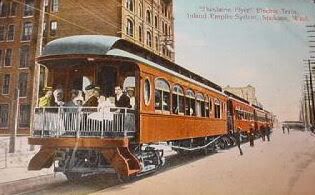Another Green Monday: A Streetcar Named Spokane
A century ago, it was the most efficient way to travel the streets of Spokane. Walking around Manito or West Central, you can see the tracks embedded in brick where the pavement is open, the final remaining physical evidence of an electric trolley car system.
Image of the Shoshone Flyer in 1909.
Although it began with horses in 1888, the Spokane Street Railway was our first mass transit and it paid for itself in eight months, converting to electric power in 1891. The electric trolleys even logged 24 million rides in 1910. However, popularity declined with automobiles and by 1936 the streetcars were literally burned and replaced with buses. You can see the photos at the Spokane Transit Authority Bus Plaza. What were they thinking?
Seeing those cracked streets, I imagine what it looked like. Recently on Pattern Cities, a beautfiul, rare video was posted of a streetcar in Barcelona 1908 to give us an idea:
[S]urely the streets of the 1900′s were not entirely crash-free, or as romantic as this film and its whimsical music make them out to be, writes Mike Lydon of the Street Plans Collaborative. “Yet, the inherent complexity -- the organized chaos of streetcars, pedestrians, horse-drawn carriages, and yes, motorists all mixing together -- is instructive and should make any urbanist long for a time when the tyranny of the automobile didn't dominate the project of city building.”
Everybody gets along- bicycles, pedestrians, the occasional car- and yes, there’s a horsedrawn carriage.
The Spokane Transit Authority and the City Of Spokane are working together to study a high performance transit service that will connect major activity centers within the central city area. It’s called the Central City Transit Alternatives Analyses. This project will compare several options such as streetcar, bus rapid transit, light rail, personal rapid transit, and others; the goal is to help create a vibrant central city, comparing the environmental impacts of the transit options and look at ways to increase regional resources and transit mobility.
Perhaps the past won’t look so different in the near-future.
